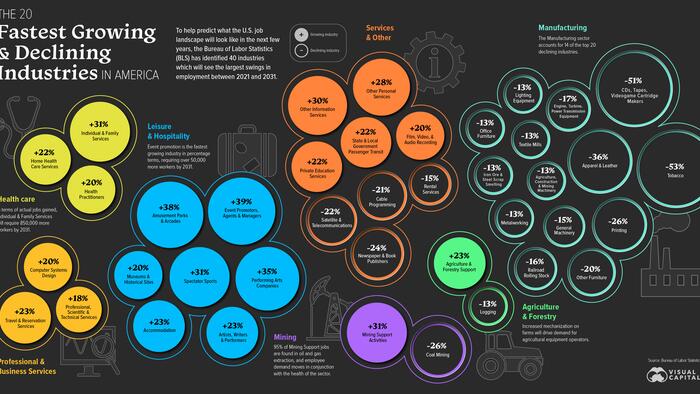


The labor force is always shifting, responding to technological or societal changes.
For that reason, keeping an eye on the fastest growing industries can help workers and businesses stay on top of the crucial trends driving employment.
Today, Visual Capitalist's Pallavi Rao looks through projections from the U.S. Bureau of Labor Statistics (BLS) on the fastest growing industries, as well as those that are the fastest declining, by percentage employment change between 2021 and 2031.
Event Promoters, Agents, and Managers top the list of fastest growing industries, with an impressive predicted growth of 39%, employing over 180,000 workers by 2031.
Amusement Parks and Arcades follows close behind, with an expected 38% increase—adding over 60,000 new employees—in the same time period. Ranked third, the Performing Arts industry will start the next decade with around a 100,000-strong workforce, up 35% from 2021.
Below is the full list of BLS’ projected fastest growing industries, ranked by percent change in employment, between 2021–2031.
(2021-2031)
(2021-2031)
Agents & Managers
Hospitality
& Arcades
Hospitality
Arts Companies
Hospitality
Family services
Activities
Hospitality
Services
& Other
Services
& Other
Reservation
Services
Business Services
Forestry Support
& Forestry
& Performers
Hospitality
Hospitality
Services
& Other
& Other
Care Services
Audio Recording
& Other
Historical Sites
Hospitality
Systems Design
Business Services
Scientific &
Technical Services
Business Services
Note: Services & Other sector includes Information, Education and State & Local Government industries.
All of the top three industries belong to the Leisure and Hospitality sector, which accounts for seven of the 20 fastest growing industries. This outsized performance reflects recovery more than pure growth, as the BLS notes that the Leisure and Hospitality sector was unduly affected by the COVID-19 pandemic, giving it a lower-than-usual baseline in 2021.
Ranked fourth by employment change percentage is Individual and Family Services, though it is actually expected to see the largest growth in total employment terms, adding 850,000 new workers by the end of the decade. It is one of three industries in the Health Care and Social Assistance sector with large projected growth, thanks to an increased need for care service due to an aging American population.
Not to be missed is Computer Systems Design, projected to grow by 20% in employment thanks to growing demand for computing infrastructure and IT security. Due the industry’s sheer size in employment force with 2.3 million workers in 2021, that’s close to half a million additional workers over the next decade.
Tobacco Manufacturing leads the group of industries expected to register employment declines by 2031, with a projected decrease of 53% in employment, bringing its already small workforce down to only 5,000 employees by the end of the decade. This stark decline is not necessarily driven by waning smoking habits, as cigarette sales in the U.S. went up during the pandemic. Instead, further automation of the industry may replace tobacco manufacturing employees.
Another industry facing a similar situation is CDs & Tapes Manufacturing, which is expected to witness a 51% reduction in employees by 2031.
Below is the full list of BLS’ projected fastest declining industries, ranked by percent change in employment, between 2021–2031.
(2021-31)
(2021-2031)
Manufacturing
Manufacturing
Manufacturing
Book Publishers
& Other
Telecommunications
& Other
& Other
Manufacturing
Transmission
Equipment
Manufacturing
Stock Manufacturing
Other
Manufacturing
Scrap Smelting
Manufacturing
Manufacturing
& Forestry
Construction &
Mining Machinery
Manufacturing
Manufacturing
Most of the industries facing large total employment contraction belong to the Manufacturing sector. The troubles of American manufacturing aren’t new, but the variety of industries presented suggests a mix of factors causing slumps across the sector.
Some industries like Printing, Cable Programming, and Newspaper and Book Publishers face shifting consumption habits.
Meanwhile, others like Textiles, Apparel, and Furniture Manufacturing are expected to suffer from further automation and shifted production abroad.
It’s important to note that these projections by the BLS were released in September 2022. That means they do not reflect the rapid rise of generative AI like ChatGPT and how they have begun to affect the economy.
A recent Goldman Sachs report, for example, stated that AI could replace 300 million jobs—almost the size of the U.S. population—around the world in the next 10 years.
That makes it an open and important question as to whether AI or powerful demographic trends, such as slower population growth and an aging workforce, will be the most impactful in terms of determining the future employment landscape.
